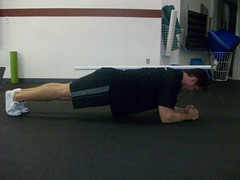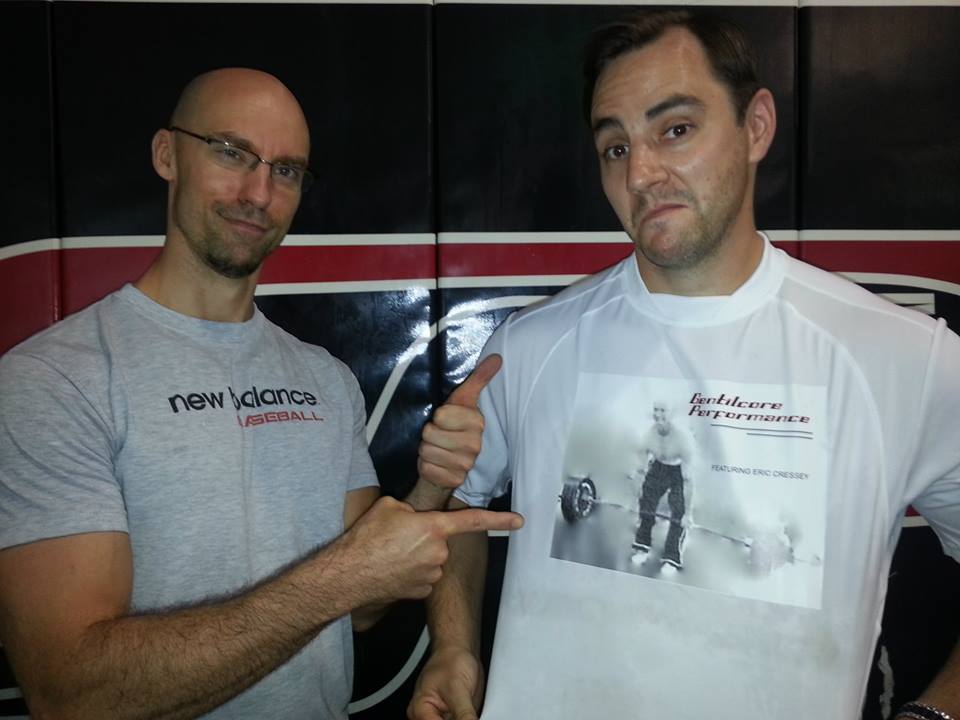I’ve been lucky to have so many people offering to write stellar content for me lately. Today I have a post by none other than Jon Goodman; friend, colleague, best selling author (Ignite the Fire), and pretty much the Don Corleone of personal training information.
He won’t leave severed horse heads in your bed, but you should listen to what he has to say if you want to do well in this industry as a personal trainer.
Today’s post deals with how you can make any exercise harder or more challenging.
So you wanna change up your routine, bro?
Not a problem and there are many options, but you’ve got to keep your goals in check. There’s wobbly boards, rolly thingies, and rubber whathaveyous that take up space in the gym and really don’t add much to anybody’s program.
Variation can put a hamper on your results if you’re not careful. So today I want to talk about variation done right. Below are 13 ways to alter any exercise; when to use each, and what to be careful of.
Some of these variations make the movement harder, some easier. Others change the purpose of the exercise altogether.
Some of these principles you may have seen before, others maybe not. I hope that, after reading this article, you know how to vary movements and loading schemes to better achieve your goal, whatever that may be.
1. Balance.
The more balanced you are, the more force you’ll be able to produce. Altering your center of mass or putting yourself off-balance changes the challenge of the exercise.
Not only that, but the closer your center of gravity is to the ground, the more balanced you’ll be. Ever take a look at the body composition of top wrestlers or judokas? They’re usually as wide as they are tall and the result is that they’re much more difficult to knock down.
If you want some real-World proof, the next time that you see Tony in-person take out his legs. The first thing that he’ll do is crouch and then probably deadlift you off of the ground and Hulk smash you.
So a few things: First, If you ever want to generate more force on a movement you can either widen your base of support (lowering yourself) or crouch down further. If you want to increase the stability challenge you can do a whole bunch of stuff ranging from standing on one leg to putting your feet together to using a variety of wobbly, bouncy, shaky things you’ll find in most gyms.
This comes with a warning — always keep your goal as the #1 priority. A squat on a Bosu ball makes the exercise harder, but it isn’t going to make you stronger. Always respect the rule of specificity.
Out of all the tools in the gym, the stability ball is Tony’s favourite.
2. Manipulate reps.
Certain exercises can have their reps manipulated more than others.
You would have a hard time performing the lateral raise, for example, in the heavy-weight/low-rep zone. The movement doesn’t allow lifting heavy loads explosively. How much to manipulate reps is contingent on your goal.
One other fun way to manipulate reps is by doing partials. In a conventional rep, tension is relieved before starting the next (i.e. locking your elbows at the top of a bench press to rest for a second before starting the next rep). In a partial, each rep becomes extended for 1 and ½ or more times putting the muscle under more tension.
Here’s Ben Bruno crushing some 1-1/2 rep ring chin-ups
3. Tempo
Tempo is ignored far too often. In order for me to talk about it, you’ve got to understand the nomenclature. Every rep of a lift can be broken up into 4 phases: eccentric, pause, concentric, pause, all measured in seconds.
A bench press with a “41X0” tempo would call for 4 seconds in the down phase; a 1 second-pause at the bottom; an explosive press (denoted by the “X”); and no pause at the top before starting the next rep.
Often when you see a workout printed in a magazine or given to you by a trainer, you’ll see 3 or 4 numbers like what I’ve noted above (sometimes the final rest isn’t listed). A tempo will change dependent on the goal of the exercise.
A blocker on a football team, for example, would do a more explosive version of the bench press – somewhere in the 20X1 range. Somebody looking for max hypertrophy is going to want more time under tension (TUT) and may opt for a 4020 on that same bench press.
4. Weight.
If it’s heavy, it’s hard.
5. Lever length.
The human body is really just a series of levers and, like any lever, the closer the load to the fulcrum the easier it will be. Now that you understand this basic biomechanical principle you know how to make any exercise easier or harder.
Want to increase the difficulty of movement? Move the weight away from the fulcrum. An example of this is performing the plank with straight arms in front of your shoulders.
Want to make an exercise easier, move the weight closer to the fulcrum. This explains, in part, why you can lift more in a bent arm lateral raise than you can with straight arms.
While this principle applies to any exercise, please note that it’s a simplistic approach. There’s some muscle physiology mumbo-jumbo like motor unit size and optimal recruitment patterns that also has an effect. For most it’s a good heuristic to train with.
Watch how Tony makes use of this transmogrification here:
6. Shape of Implement.
While not always commercially available, odd-shaped implements are fun to lift and can add in a new dimension to training. One could argue that it’s also a more functional way to train (although the word “functional” has lost all meaning). Sandbags, for example, have uneven and changing weight distribution. Be creative and you can build some fun equipment pretty cheap.
Perhaps the most common example today is the kettlebell. Because the weight distribution isn’t uniform (the weight is concentrated at the end) the bell generates more inertia farther away from the body. This forces a different muscle engagement pattern than a conventional weight – even swinging a DB is different. The extra inertia caused is the primary reason why it’s such an effective piece of equipment to develop the posterior chain.
For years I organized a get together every Sunday morning in the summer. Along with my kettlebells, my arborist friends brought rope (makeshift battle ropes), and we built tools like slosh pipes from PVC piping bought at Home Depot.
You can have some fun with this. Don’t think that you need to lift perfectly symmetrical DB’s and lubed-up machines to get strong.
The video below shows Tony doing a suitcase carry with a rope slung around a kettlebell. The instability and grip challenge here will definitely be different from anything you’ve done before.
7. Stance.
Despite popular belief, the only way to stand when performing an exercise is not with soft knees and your feet shoulder-width apart. Stance, when manipulated properly, is a powerful variable that can jumpstart your program. Here are my favorite variations:
Split stance. This is easier on the back and allows you to maintain a strong posture. The wider the split, the more balanced you’ll be. Switch the leading leg evenly to get an oblique benefit on each side.
Kneeling. A great way to get the abs firing on a host of upper body exercises is to do them on your knees. Instead of sitting on a bench or ball, do your shoulder presses or biceps curls kneeling maintaining a strong upright posture. This variation is especially good for me because I travel a lot and heavy weights are hard to find. That, and the extra ab work doesn’t hurt, you know, for the beach.
Half-kneeling. This is in-between standing and kneeling. There’s a great core benefit here and the glutes on the side of the resting leg will fire as well. Not only that, but you’ll get a nice stretch in the hip of the trailing leg.
Wide stance. A wide stance makes it easier to balance. It also gives the adductors a stretch, which almost every lifter needs. It’s probably not advantageous for most exercises but works well for things like cable chops.
8. Slow Eccentrics (Negatives).
A “negative” is a very slow, controlled contraction that causes a lot of muscle damage. These should only be used for advanced trainees and definitely only with sets of fewer than 3 to 5 reps. A negative usually lasts around 10 seconds. Use a spotter to assist in the concentric portion of the lift or do an easier variation of the exercise as a “cheat” to get the weight back up.
Negatives will make you very, very sore the next day and are only advised for advanced lifters. They’re especially good for breaking through plateaus.
In the video below, notice how Tony’s client is jumping up, or cheating, and then focusing on the eccentric, or negative, phase of the movement.
9. Rest Time.
Rest between sets is another one of those variables that isn’t used properly often enough. Most people have an idea of how long they should rest but few give it the conscientious attention that it deserves. A basic overview:
0-45 seconds of rest builds endurance.
45 seconds to 90 seconds (1.5 minutes) of rest builds muscle.
1.5 minutes and more of rest is for strength training.
Have a stopwatch with you. Set it to your rest interview. The minute that you finish a set, hit the button. When the timer beeps noting the end of your rest, start right away. Don’t screw around in the gym if you’re serious about your results.
You can vary the rest intervals by decreasing or increasing the time (duh). Decreasing the time will make the exercise more aerobic. You won’t be able to lift as much weight but if you’re looking for fat loss it may be warranted. Increasing the rest period to a maximum of 3 minutes is advised for power training. Higher rep ranges are generally used on large multi-joint exercises like a squat or bench press if the lifter wants to keep the reps low and lift heavy.
10. Loading Schemes.
Loading schemes can add or decrease intensity of a workout, or the challenge to a particular muscle group. I use the term “loading schemes” to describe the order that exercise appear in relation to one another.
There are too many to list here but two favourites are pre-fatigue and post-fatigue.
Pre-fatigue. This is when an exercise is performed that exhausts a single muscle group, immediately followed by a multi-joint exercise using that muscle. This can be dangerous if the lifter isn’t experienced. For example I wouldn’t perform hamstring curls before a deadlift unless the lifter has a couple years of lifting experience.
Post-fatigue. This is when a multi-joint exercise is followed immediately by a single joint movement using one of the main muscles of the multi-joint movement. For example, a deadlift followed by a hamstring curl would be considered post-fatigue. I use this loading scheme often when ramping up intensity and volume in my programming.
What it comes down to is this: Despite what your high school gym teacher told you, there are other ways to build a program than starting with a large multi-joint exercise followed by isolating muscle groups and ending with abs before a slow jog.
11. Pauses.
Pausing could be incorporated into the earlier discussion of tempo but I decided to give it its own category. Momentum is a powerful way to generate force but sometimes it’s not warranted. Pausing can be used for 3 purposes:
Increase intensity – Pauses at various stages of a rep can lengthen the total time under tension (TUT) of a rep, adding to the difficulty of each set.
Improve power generation – Lifting with momentum (like bouncing the weight on a deadlift) can be good or bad. If you’re working on your power then you probably want to avoid it. Additionally, pauses can be good to strengthen weak points of a lift.
Learn form – You cannot unlearn habits. Instead you’ve got to learn a new habit powerful enough to replace the existing one. It follows that the stronger an existing habit, the harder it will be to replace it. When learning a new exercise it’s important to only practice it well. This generally means reducing fatigue in the learning stage. Pauses after each rep to recompose yourself and ensure good form will speed up the learning curve.
The video below shows Tony pauses and resetting himself after each rep of a deadlift to improve the speed of the lift.
12. Range of Motion (“ROM”).
We’re taught to perform full ROM movements all the time and, for the most part, it’s a good idea. There are times when cheat techniques of semi-reps are warranted as long as they’re performed safely.
I always said:
“If the choice is to get 0 percent because you cannot perform a full rep or get 30 percent and perform a partial rep. I would choose the 30 percent.”
Partial reps are also great for keeping constant tension on the muscle. The next time that you do lunges don’t lock out at the top, keep tension on your hammies and glutes the entire set. It’s nasty. You’ll see what I mean.
If you’re already proficient with your form then partial reps can add more intensity into the movement. Especially on arm day. You know, for the pump.
13. Grip.
I saved grip for last because of how strongly I believe every trainee should master it. Different grips force the body into different positions, engage different recruitment patterns, and force the body to use different muscles.
There are countless ways to alter the grip on most major exercises. I’ll use the chin/pull up as an example. You can perform the exercise with your hands wide, medium, or close together. It can be done on a thick bar; a thin bar; rings; or even playground equipment. You can also grip the bar with your palms facing up, down, or each other. These are just some examples.
Note from TG: here’s a video of a former 50+ y/o client of mine performing chin-ups with softball grips. And yes, she’s shrugging a bit on her reps…..relax.
Every major exercise has a host of different grips. These nuances are what makes training fun and interesting. If you’ve been doing a lat pull down or chin up for a while, change your grip to any-or a combination of the options I’ve listed above.
Thank me tomorrow when you have to ask a friend to help you open a door.
I mentioned at the beginning of this article that the human body is relatively simple when you break it down. A muscle only has so many functions. The biceps flexes the elbow and internally rotates; the pec major flexes, internally rotates, and horizontal adducts (think pec fly); the gastrocnemius (calf) points the toe; and so on.
When you consider all the ways to vary an exercise it’s easy to see how diverse your options are. Have fun, but don’t lose sight of your goal.
Also, I made up the word transmogrify and then I found it that it was actually a real word. Guess I did learn something from Calvin and Hobbes, eh?
About the Author
Jonathan Goodman is the author of Ignite the Fire, a book that teaches how to become a personal trainer and build a successful career. To learn more about his personal training books and free collaborative resource for trainers, go to the Personal Trainer Development Center.











